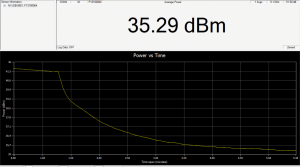An RF Power Amplifier (PA) or Bi-Directional Amplifier (BDA) is able to detect a low-powered RF signal and amplify it to a higher amplitude, providing a variety of useful applications, such as extending the range of Unmanned Aerial Vehicle (UAV) datalinks. Any device generating high power will also result in the generation of heat. For this reason, PAs require a method of sinking the heat away from the device, whether it be mounted to a specially designed heat sink or in a system that provides adequate thermal transfer between the device and the system. But what happens if the device is generating heat faster than the system pulls it away? How can we keep our device protected?
A feature that designers may implement into a PA to keep it protected is temperature-controlled circuitry, which may shut down the internal amplifier(s) in order to allow the device to cool down to a safe level before turning back on. With these devices generating high power, and therefore heat, the operating temperature of many internal components can quickly exceed the threshold and cause permanent damage. This temperature-controlled circuitry is configurable by the designer to trigger at a precise temperature, preventing the device from ever reaching this damaging level.
In all of the commercial PAs offered by NuWaves RF Solutions, a temperature monitor circuit is implemented in order to monitor the internal temperature and trigger the device to shut down if the temperature exceeds its configured setpoint. Generally, these products shut down completely if an internal temperature of approximately 85°C is exceeded. The internal temperature must decrease to approximately 70°C before the unit will turn back on.
During this shutdown period, the device will be unable to transmit and the Temp Flag lead of the supplied interface power cable will go low, indicating to the user that the internal temperature has been exceeded. Some products offered by NuWaves RF Solutions have added a newer “temperature back off” feature, where instead of shutting down completely, the device draws back on the output power. This reduces the amount of heat generated internally while still transmitting a signal (see Figure 1 below).
 Figure 1: Power Meter Display of Power vs. Time
Figure 1: Power Meter Display of Power vs. Time
In Figure 1 above, a device was tested in the lab without any heat sinking. The unit began outputting full power of approximately 41.5 dBm. At 1.3 minutes on the graph above, the trip point was exceeded and the power began drawing back quickly. At approximately 5 minutes in, the power backed off enough to prevent the device from completely shutting down and remained at a constant output power of 35.3 dBm. The test was running at room temperature; however, if this test was performed in an environment with higher ambient temperature, the device would completely shut down and the Temp Flag lead of the interface cable would go low.
It should be noted that this is used as a method of protecting the device and is not recommended for normal operating conditions. This feature will not be triggered in a system that provides adequate heat sinking. If your system does not provide adequate heat sinking, NuWaves RF Solutions also offers an optional heat sink for each PA or BDA. Check out a full line up of our products and contact us with any questions.



Comments are closed